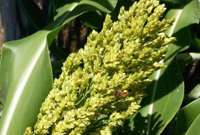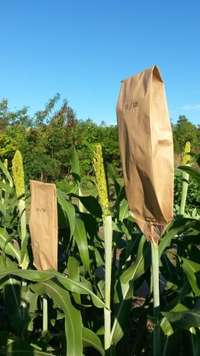
Figure 3: Sorghum cross-pollination can take place through insect transfer. Photo by Holly Sobetski.
Sorghum is primarily self-pollinated, meaning that a sorghum plant will accept pollen from its own flowers. Sorghum can also accept pollen from other sorghum plants (cross-pollination) by means of wind or insect transfer (note the bee on the sorghum head in Fig. 3). Cultivated sorghum is generally cross-pollinated between 2 and 10%, with wild varieties crossing even more.
Floral initiation happens deep within the plant 30 to 40 days after germination. The flag leaf is the last leaf to emerge on the plant, and is usually smaller than the other leaves. It begins to bulge with the developing flower head 6 to 10 days before flowering takes place, and flowering happens between 55 and 70 days after germination. Flowers start to open two days after the sorghum head emerges from the flag leaf. Maximum flowering occurs on the third or fourth day, and it takes six days for the whole inflorescence to completely flower (although it could take from 4 to 13 days, depending on the type). Flowering (the emergence of the anthers and stigma) starts at midnight and goes until 10 am, with the best flowering occurring between 6 and 8 am.
The stigma (female part) receives pollen from the anther (male part) before the flower even opens. But the stigma also remains receptive for 10 days, which means pollen can be accepted from other flowers during that time. Pollen remains viable for 3 to 6 hours in the anther and 10 to 20 minutes outside of it. Fertilization takes 2 hours, and the grain matures 30 to 35 days after fertilization.
Cross-pollination, or outbreeding, introduces new genes and traits to plants. This can be helpful for improving sorghum production and growth. But, if you have an open-pollinated variety that produces well and you want to save the seeds from it, you can ensure the purity of the cultivar by planting it at least 200m (656ft) away from other varieties. Remove plants that are too short, too tall, diseased, etc., before flowering takes place.

Figure 4: Example of a pollinating bag used to prevent cross-pollination in sorghum. Photo by Holly Sobetski.
If varieties are growing closer than 200m apart and you want to save seeds of a specific variety, you can use pollinating bags to prevent cross-pollination (Fig. 4). A pollinating bag or mesh bag can be used right before or right after the plant starts to flower, allowing the plant to completely self-pollinate and ensuring the purity of the seed.
First, snip off any open florets (the exposed anther and stigmas will be obvious; the head flowers from the top to the bottom). This prevents the development of seeds from flowers that could have already cross-pollinated. Then, cut the flag leaf at the base. Put the dated bag over the entire panicle, allowing at least 5 inches between the bottom of the head and the bottom of the bag. Fold the sides of the bag over and paper clip. Leave the bag in place for 10 to 15 days, so flowers have sufficient time to open and to finish fertilization. When the bag is removed, it can be wrapped around the stalk and stapled to show that seed head was bagged.
During the rainy or humid season, sorghum heads tend to get moldy in the bag, so bagging has the best results when practiced in the dry season.
Sorghum provides an important summer fodder where temperatures are high and rainfall is insufficient for corn. Most sorghum is grown for grain, forage, fuel, fiber, syrup and/or sugar. Cleaned grain can be cooked like rice or ground into flour.
The ECHO Florida Seed Bank offers sample size packets of the following sorghum varieties (log into your account on ECHOcommunity.org to view the seed catalog):
Bird Resistant – a dwarf, white-seeded variety that contains tannins, giving the unripened grain a bitter taste. The tannin content decreases as the grain matures and is lowest when the grain reaches 16-18% moisture content. Can be used as a feed, however it is a less desirable feed crop. Developed at Purdue University.
Broomcorn – used as a source of fiber for brooms and brushes. The best brush is produced where the summers are warm and the soils are moist and fertile. Stalks can also be used to make paper; the pulp is used to manufacture craft paper, newsprint and fiberboard.
Forage – a tall-growing sorghum used for animal feed and silage. Provides an important summer fodder where temperatures are high and rainfall is insufficient for corn.
Giza 114 – solid-stalked sorghum that burns at a high temperature and is used for fuel. Grain heads are also desirable for feed. Produces a variety of colored grain.
Red’s Red Sweet – a variety of sweet sorghum that grows well at ECHO Florida. The cane is processed into sorghum molasses.
Striga Resistant – this sorghum produces desirable grain for feed and is resistant to striga, a particularly noxious parasitic weed that has been the most detrimental in sub-Saharan Africa where drought and low soil fertility already make it difficult to grow a good crop. Developed at Purdue University.
Source: Training Manual: Development of Cultivars and Seed Production Techniques in Sorghum and Pearl Millet, ICRISAT 1997
Cite as:
Sobetski, H. 2015. Sorghum Pollination. ECHO Development Notes no. 126